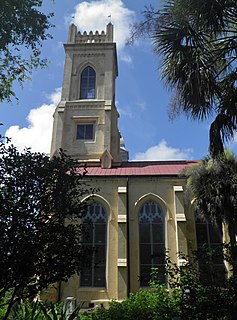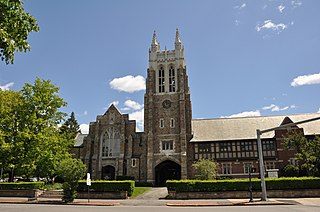
Unity Temple is a Unitarian Universalist church in Oak Park, Illinois, and the home of the Unity Temple Unitarian Universalist Congregation. It was designed by the American architect Frank Lloyd Wright, and built between 1905 and 1908. Unity Temple is considered to be one of Wright's most important structures dating from the first decade of the twentieth century. Because of its consolidation of aesthetic intent and structure through use of a single material, reinforced concrete, Unity Temple is considered by many architects to be the first modern building in the world. This idea became of central importance to the modern architects who followed Wright, such as Ludwig Mies van der Rohe, and even the post-modernists, such as Frank Gehry. In 2019, along with seven other buildings designed by Wright in the 20th century, Unity Temple was added to the UNESCO World Heritage List.

The First Unitarian Church of Oakland is located in western Downtown Oakland, California. It is a member of the Unitarian Universalist Association.

The Unitarian Church in Charleston, home to a Unitarian Universalist congregation, is an historic church located at 4 Archdale Street in Charleston, South Carolina. It is the oldest Unitarian church in the South and the second oldest church building on the peninsula of Charleston.

First Universalist Church is a registered historic building in Cincinnati, Ohio, listed in the National Register on March 3, 1980.

All Souls Unitarian Universalist Church, built in 1894 in the Richardsonian Romanesque style is an historic building located at 25 Church Street in Bellville, Ohio. On January 1, 1976, it was added to the National Register of Historic Places.

The First Unitarian Universalist Society in Newton occupies a prominent location at 1326 Washington Street in the heart of the village of West Newton in Newton, Massachusetts. Architect Ralph Adams Cram designed the church, Frederick Law Olmsted Jr. designed the grounds, the cornerstone was laid in 1905, and it was dedicated in 1906; it is one of the village's oldest buildings. The church is in Cram's signature Gothic Revival style, with buttressed walls and a blocky square tower with crenellations and spires. An enclosed courtyard is formed by an office wing, banquet hall, and parish house, which are built to resemble Elizabethan architecture with brick first floor and half-timbered upper level.

The First Unitarian Church of Detroit was located at 2870 Woodward Avenue in Midtown Detroit, Michigan. Built between 1889 and 1890, it was listed on the National Register of Historic Places in 1982. It was destroyed by fire on May 10, 2014.

Unitarian Memorial Church is a historic church on 102 Green Street in Fairhaven, Massachusetts, home to the Unitarian Universalist Society of Fairhaven.

First Parish Church in Plymouth is a historic Unitarian Universalist church at the base of Burial Hill on the town square off Leyden Street in Plymouth, Massachusetts. The congregation was founded in 1620 by the Pilgrims in Plymouth. The current building was constructed in 1899.

First Parish Church is an historic church located within the Church Green Historic District in Taunton, Massachusetts. It is the fourth meetinghouse since 1647 to be located on what was the original town common. The current church building was built in 1830, constructed of field stone in the Gothic Revival style.

St. John's Protestant Episcopal Church is an historic church located at 628 Main Street in Stamford, Connecticut. The church is an English Gothic Revival structure, built in 1891 to a design by William Potter. It has buttressed stone construction, with a compound-arch entry and a large rose stained-glass window. The associated parish house, also a Gothic Victorian structure, was designed by Richard Upjohn and built in 1869–72.

St. Mary's is a cathedral-style church located at 566 Elm Street in Stamford, Connecticut. The church is part of the Roman Catholic Diocese of Bridgeport. The main building is a Gothic Revival structure, designed by Francis L. S. Mayers and completed about 1928. It is an elegant example of French Gothic architecture, notable for the large rose window in the front-facing gable end. The rectory is a c. 1860 Italianate villa, originally built for a member of the locally prominent Wardwell family.

The Universalist Unitarian Church is a historic church on Silver Street and Elm Street in Waterville, Maine in the United States. Built in 1832 for a Universalist congregation founded in 1826, it is a prominent local example of transitional Federal-Gothic Revival architecture. It was listed on the National Register of Historic Places in 1978.

Pittsfield Universalist Church is a historic church at 112 Easy Streets in Pittsfield, Maine. Built in 1898-99 with parts dating to 1857, it is one of the town's finest examples of Queen Anne architecture and is noted for its artwork and stained glass. The building was listed on the National Register of Historic Places in 1983.

Christ Church, more commonly known as the Unitarian Universalist Fellowship or First Universalist Church of Middletown is a historic Universalist church located at Middletown in Orange County, New York. It was built in 1901. It features an offset bell tower and Tiffany glass memorial window. Also located on the property is an earlier frame parish house.

The First Congregational Church of Oregon City, also known as Atkinson Memorial Congregational Church, is a historic building located at 6th and John Adams Sts. in Oregon City, Oregon. The congregation was formed in 1844 as a non-denominational Protestant congregation. In 1892 they affiliated with the Congregational Christian Church from the local Congregational Society that had been formed in 1849 from the 1844 congregation. The present building was constructed in the Gothic Revival style in 1925 after the previous building had been destroyed in a fire in 1923. It was listed on the National Register of Historic Places in 1982.

The Unitarian Universalist Church of Buffalo is a historic church complex located at 695 Elmwood Avenue, in Buffalo, New York. The building was designed by architect Edward Austin Kent in 1906. Kent died in 1912 aboard the RMS Titanic and a memorial plaque is located in the church honoring him.

The Housatonic Congregational Church is a historic church building at 1089 Main Street in Great Barrington, Massachusetts. Built in 1892 it is a prominent local example of Queen Anne Revival architecture, and was listed on the National Register of Historic Places in 2002. It is now home to the Unitarian Universalist Meeting of South Berkshire.

All Souls Church, also known as All Souls Unitarian Universalist Church of Braintree, is a church on the National Register of Historic Places, it is located at 196 Elm Street in Braintree, Massachusetts. The building is a large fieldstone structure, in a cruciform plan with a square tower that has a crenellated top. The gable ends are decorated with bargeboard, and the entrance is set under a gabled entry porch below a large window with Gothic tracery. The church was designed by Boston architect Edwin Lewis and built in 1905 for a congregation organized in 1900; it is Braintree's first stone church building. Land for the building was donated by George O. Wales, a leading force in uniting Braintree's Unitarian and Universalist congregations.

Theodore Parker Unitarian Universalist Church is a historic church building at 1859 Centre Street in the West Roxbury neighborhood of Boston, Massachusetts. Built in 1900 to a design by West Roxbury native Henry M. Seaver, it is a locally significant example of Normanesque architecture, and is adorned by stained glass windows created by Louis Comfort Tiffany and his firm. The church was listed on the National Register of Historic Places in 2020. The congregation it houses was founded in 1712, and is named for the influential Transcendentalist and abolitionist Theodore Parker, who was the congregation's minister in the 1840s.






















